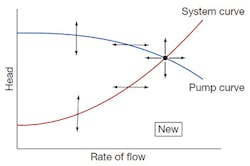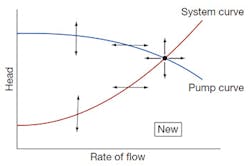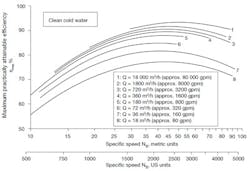This is the fifth part of a series based on Optimizing Pumping Systems: A Guide to Improved Energy Efficiency, Reliability, and Profitability, written by pump systems experts. This new guidebook continues the mission of Pump Systems Matter and the Hydraulic Institute to advance knowledge on pumping systems.
Pumping systems play a crucial role in the operation of most industrial processes. The initial cost of a new pumping system is a small portion of the cost to operate a system over its life, which can be more than 15 years. Proper pumping system design is the single most important element in minimizing life cycle cost (LCC). Therefore, optimum efficiency in designing and operating pumping systems is in the best interest of all facilities.
New pumping systems provide a number of cost reduction opportunities that are typically cost prohibitive when applied to an existing system. At the design stage, the pump design engineer has control of more cost-reducing variables and may anticipate and account for cost reduction opportunities that would normally present themselves after the pump has been operating for several years. Design requirements are a critical aspect of both the initial and life cycle costs of a pumping system. Therefore, the design stage is an opportune time to review requirements to ensure excessive margin does not exist.
Initial Cost Versus Life Cycle Costs
Figure 1. System curve and pump curve
Typically, firms that specialize in the construction market are primarily focused on initial cost, since contracts and bid evaluations are not structured to reward the engineer or contractor for optimizing life cycle costs. This approach ultimately increases the life cycle costs of the pumping system because compromises on the technical side lead to the selection of equipment with average or below average performance. The initial cost is not a significant portion of the total costs, so any new project should focus on the minimization of life cycle costs, not initial cost.
Competing Effects of Initial & Life Cycle Costs
Initial, energy and maintenance costs depend directly on the diameter of the pipework and the components in the pipework system. The pipework diameter is selected based on the following factors:
• Economy of the whole installation (pumps and system)
• Required lowest flow velocity for the application (e.g., avoid sedimentation)
• Required minimum internal diameter for the application (e.g., solids handling)
• Maximum flow velocity to minimize erosion in piping and fittings
• Plant standard pipe diameters
Increasing pipe run size will increase some costs while decreasing others. Thus, an optimum pipe run size may be found based on minimizing costs over the life of the system.
Operating Points Have Costs
Pump selection, including impeller size and operating speed, will affect the operating point of the system by shifting the pump curve. An important part of designing an efficient system is selecting a design with an operating point that is close to the BEP (best efficiency point).
In a system that requires control features, the pumping system design engineer may choose between controls that are pump-centric (such as VFDs) or valve-centric (or use a bypass line). Both control methods will change the operating point, but pump-centric controls provide a much greater opportunity to change the pump curve and operating point in such a way as to reduce cost. Automation or intelligent VFDs can be used in conjunction with a programmable logic controller (PLC) to direct the pumps to operate at an optimized efficiency. For a system with multiple pumps in parallel, the composite pump curve can be altered by turning some pumps off, thereby shifting the operating point.
Shifting the system curve via system design can also affect the operating point in such a way as to reduce initial or life cycle costs. The piping size and material will heavily influence the system resistance, and hence the system curve. Figure 1 shows all possible directions in which the pump and system curves can be shifted, and the corresponding effects on the operating point of the system. This is based on a newly designed system.
The Optimal Operating Point
For every pump system, there exists an operating point that achieves the lowest cost option. This concept is known as the optimal pumping system operating point (OPSOP). The pump designer has significant influence over the operating point and attempts to move the design towards the OPSOP. However, the vast number of uncertainties associated with actual system requirements, equipment characteristics and how the system is operated and degrades make it difficult to identify this operating point and impossible to achieve the optimum state.
Finding the Optimal Design
Pumping systems can have a seemingly infinite number of design variants. Numerical optimization allows the pump system designer to find a design with an operating point near the OPSOP by sifting through a small fraction of possible designs. Numerical optimization uses the following steps:
• Numerically perturb the engineer’s design.
• Repeatedly reanalyze the system hydraulics.
• Define the shape of the design space.
• Identify combinations of design parameters that reduce cost.
• Present the lowest cost option to the engineer.
More importantly, numerical optimization allows for the cost of pump and system oversizing to be quantified before the design is finalized, which typically leads to more informed decisions during the design stage.
Margin in System Design
All pump systems have a certain amount of overdesign, known as design margin. In general, design margin is intended to cover three broad areas:
• Design imperfection or error;
• Pump and system degradation; and
• System requirements that may change over time.
When optimizing a new pump system design, a common concern is that the optimization process will eliminate the design margin. Without margin, various events may render the pump system unable to meet requirements or process guarantees. Design margin may be introduced to the system through intentional and unintentional sources. Intentional margin is introduced into the design through the design requirements or by the designer; unintentional margin is introduced because of imperfect design methods and unwarranted assumptions. Since unintentional margin is not quantifiable and may be overly conservative, the role of optimization should be to eliminate all unintentional margins. This will produce a system with a quantifiable design margin capable of meeting both initial and anticipated requirements.
How Pumping Systems Change Over Time
Figure 2. Attainable efficiency
The conditions that exist at initial start-up of a pump may change over time due to passive or active influences. Table 1 lists some of the passive and active influences that can change the pumping system in ways that can have serious consequences on the pump’s operation. A change in the pumping system can affect the pump’s flow, efficiency, power consumption, maintenance needs, and useful service life. Therefore, it can be advantageous to design a flexible or resilient system that can adapt to varying conditions over time.
As the system ages or operational requirements change, the head generated by the pump may need to increase. If the pump impeller was selected at less than maximum diameter, the pump head may be increased by substituting a larger diameter impeller. This will increase the power requirements of the pump, so consideration must be given to the cost effectiveness of specifying an oversized driver for the initial duty.
Selecting for Maximum Attainable Efficiency
The expected efficiency of a centrifugal pump varies as a function of specific speed and BEP rate of flow, and can be influenced by a wide range of available construction and design features for specific pumping applications. The theoretical values of maximum obtainable efficiency shown in Figure 2 provide a good indication of what is typically achievable in the centrifugal pump industry with good design and manufacturing practices.
Pump Corrosion, Erosion & Fouling
The pumped liquid can significantly affect the pump efficiency and reliability over time. Corrosion, erosion, and fouling will reduce the pump efficiency due to increasing surface roughness within the pump. Suggested solutions to these problems are shown in Table 2 below.
Pump Design Speed
Typically, pump system designers have the option of selecting either a small pump running at a higher speed or a larger pump running at a slower speed. The larger pump will have a higher initial cost. However, larger pumps tend to be more robust and lightly loaded than small pumps and therefore have significantly lower maintenance costs. In general, it can be assumed that pump wear and maintenance costs increase with increasing pump speed. Large differences in pump efficiency may be possible between the two designs. The user is cautioned that the energy cost of selecting a less efficient pump may far outweigh any expected maintenance or service life improvement costs.
Control Scheme Optimization – Commissioning the Pumping System
Take great care in defining the control limits and parameters of a pumping system during the start-up phase to ensure that once set into motion, it will operate within the limits defined by the designer and equipment manufacturers. In particular, the
following parameters should be closely monitored during
commissioning:
• Liquid levels;
• Speed range;
• Verification of flow and pressure;
• Control device parameters; and
• Variable-speed drive/system control options.
Learning how to design better new pumping systems and to optimize existing pumping systems are the challenges that future engineers will face. Considering the rising costs of energy and the pressing need to address climate change, industrial plants are looking for new ways to lower operating costs and reduce greenhouse gases. Helping management understand the financial justification for pumping system optimization is necessary for project approval.
The economics of pumping systems will be explored in greater detail in the next installment of this series of articles based on Optimizing Pumping Systems: A Guide to Improved Energy Efficiency, Reliability and Profitability.
Gregg Romanyshyn is the technical director at the Hydraulic Institute. In this position, he oversees the technical aspects related to the Hydraulic Institute. Mr. Romanyshyn has over 30 years experience involved with pump related businesses and has been at the Hydraulic Institute for 10 years. The Hydraulic Institute is the largest association of pump industry manufacturers in North America and serves the pump community by providing product standards, guidelines, and references, and is a forum for the exchange of industry information.
www.Pumps.orgwww.PumpSystemsMatter.org
References
1. ANSI/HI Pump Standards. For more information on these standards visit estore.Pumps.org/.
2. Optimizing Pumping Systems, A Guide to Improved Energy Efficiency, Reliability, and Profitability. For more information on HI Guidebooks, visit www.Pumps.org.
Hydraulic Institute Members and Pump Systems Matter Sponsors contributed to the content of this article.
Free Stuff from the Hydraulic Institute and Pump Systems Matter>> The Pump System Improvement Modeling Tool™ (PSIM) is valuable software focused on helping pump users better understand the hydraulic behavior of pumping systems so that they may evaluate the design of their overall pump system.
>> Life Cycle Cost Guide, a 16-page Executive Summary of the detailed and more complete guidebook, Pump Life Cycle Costs: A Guide to LCC Analysis for Pumping Systems, a collaborative effort between the Hydraulic Institute (HI), Europump, and the U.S. Department of Energy (DOE).
>> Another free download that focuses on energy savings is a 15-page Executive Summary of the popular guidebook, Variable Speed Pumping: A Guide to Successful Applications, a collaboration between the Hydraulic Institute (HI), Europump, and the U.S. Department of Energy (DOE).
>> An Executive Summary of the most comprehensive book to date on optimizing pumping systems, Optimizing Pumping Systems: A Guide to Improved Energy Efficiency, Reliability and Profitability, is also included in the free offering. You will find links to free downloads of:
• Pump System Basic Assessment Guide
• Pump Life Cycle Cost Calculation Tool
• Pump System Assessment Tool Matrix
• Pumping System Assessment Tool (PSAT)
• Variable Speed Drives Make “Cents” – an On-Demand Webinar
• Pump Systems Performance Impacts Multiple Bottom Lines – an On-Demand Webinar
• Superior Energy Performance (SEP) Program – an On-Demand Webinar
• What’s New with HI Standards – an On-Demand Webinar







